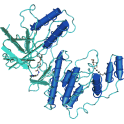
- Remove this product from my favorite's list.
- Add this product to my list of favorites.
Products
Newsletter
 |  |  |  |  |  |

Background: The p38 MAPK (mitogen-activated protein kinase) pathway contains protein kinases which engage in respond to various extracellular stimuli an intracellular signalling cascade coordinating the activation of gene transcription, protein synthesis, cell cycle machinery, cell death, and differentiation. The different p38 MAPK family members (p38α, p38β, p38γ, p38δ) encoded by different genes show an approximately 60% identical in their amino acid sequence but have different tissue expression patterns. p38 MAPKs being activated by dual phosphorylation of the Thr-Gly-Tyr in the activation loop sequence by MKKs/MAP2Ks (MKK6 and MKK3). Down-regulation of p38 MAPK is achieved for instance by Wip1, a phosphatase of the PP2C family that can be transcriptionally up-regulated by p53 or by MKPs, a family of dual-specificity protein phosphatases. Upon activation p38 MAP kinases can phosphorylate substrates on Ser-Pro or Thr-Pro motifs on MSK1 and 2, which directly phosphorylate the transcription factors CREB, ATF1, or cytosolic proteins such as phospholipase A2, Bcl-2 family proteins and cyclins. Because of the important role of p38α in inflammatory diseases such as psoriasis or arthritis it is also an interesting pharmaceutical target. Based on SB203580, one of the first discovered p38α inhibitors structurally diverse p38α and p38β inhibitors have been developed with both enhanced potency and specificity.
Human p38 alpha / SAPK2 alpha, recombinantly expressed in E. coli, N-His fusion protein. Inactive form of p38 alpha / SAPK2 alpha, which is not activated by phosphorylation by MKK6 and thus serves as a negative control for p38 / SAPK2 phosphorylation.
Expression system: E. coli
Molecular weight: 42.7 kDa
Storage buffer: 25 mM Tris-HCl, 150 mM NaCl, 1 mM DTT, 50 % glycerol, pH 8.5
Protein concentration: 1.0 mg/ml (Bradford with BSA as standard)
Purity: > 95% by SDS PAGE
Specific activity: 100 U*/mg
Entrez Gene ID: 1432
UniProtKB: Q16539
Ordering information: shipped on dry ice
Figure: Real-time kinetic analysis of kinase inhibitor SB203580 binding to p38α using surface plasmon resonance.
We provide our Kinascreen services to kinetically characterize small molecule kinase inhibitors for all p38 isoforms (p38α, p38β, p38γ and p38δ) in their phosphorylated (activated) and unphosphorylated (non-activated) state.
Please contact our application specialists to obtain more information and an individual quote tailored to your specific needs.
Product specific literature references:
Schwenger P, Bellosta P, Vilcek J et al (1997) "Sodium salicylate induces apoptosis via p38 mitogen-activated protein kinase but inhibits tumor necrosis factor-induced c-Jun N-terminal kinase/stress-activated protein kinase activation" Proc Natl Acad Sci U S A. 94(7):2869-73
Deak M, Clifton AD, Lucocq LM, Alessi DR (1998) "Mitogen- and stress-activated protein kinase-1 (MSK1) is directly activated by MAPK and SAPK2/p38, and may mediate activation of CREB" EMBO J. 17(15):4426-41
Huot J, Houle F, Rousseau S, Deschesnes RG, Shah GM, Landry J (1998) "SAPK2/p38-dependent F-actin reorganization regulates early membrane blebbing during stress-induced apoptosis" J Cell Biol. 143(5):1361-73
Rolli M, Kotlyarov A, Sakamoto KM, Gaestel M, Neininger A (1999) "Stress-induced stimulation of early growth response gene-1 by p38/stress-activated protein kinase 2 is mediated by a cAMP-responsive promoter element in a MAPKAP kinase 2-independent manner" J Biol Chem. 274(28):19559-64
Rolli-Derkinderen M, Gaestel M (2000) "p38/SAPK2-dependent gene expression in Jurkat T cells" Biol Chem. 381(3):193-8
Ono K, Han J (2000) "The p38 signal transduction pathway: activation and function" Cell Signal. 12(1):1-13
Casanovas O, Miro F, Estanyol JM, Itarte E, Agell N, Bachs O (2000) "Osmotic stress regulates the stability of cyclin D1 in a p38SAPK2-dependent manner" J Biol Chem. 275(45):35091-7
Laferriere J, Houle F, Taher MM, Valerie K, Huot J (2001) "Transendothelial migration of colon carcinoma cells requires expression of E-selectin by endothelial cells and activation of stress-activated protein kinase-2 (SAPK2/p38) in the tumor cells" J Biol Chem. 276(36):33762-72
Kumar S, Boehm J, Lee JC (2003) "p38 MAP kinases: key signalling molecules as therapeutic targets for inflammatory diseases" Nat Rev Drug Discov. 2(9):717-26
Shin J, Park B, Ahn K eta al. (2004) "Promyelocytic leukemia is a direct inhibitor of SAPK2/p38 mitogen-activated protein kinase" J Biol Chem. 279(39):40994-1003
Saklatvala J (2004) "The p38 MAP kinase pathway as a therapeutic target in inflammatory disease" Curr Opin Pharmacol. 4(4):372-7
Recombinant human MAP kinase 14 / p38 alpha, active, 10 µg - 465,00 €
Recombinant human MAP kinase 11 / p38 beta, active, 10 µg - 345,00 €
Recombinant human MAP kinase 12 / p38 gamma, active, 10 µg - 315,00 €
Recombinant human MAP kinase 13 / p38 delta, active, 10 µg - 315,00 €
Recombinant human biotinylated MAP kinase 11 / p38 beta, unactive, 5 µg - 295,00 €
Recombinant human biotinylated MAP kinase 13 / p38 delta, unactive, 5 µg - 295,00 €
Welcome Login
Contact us
Follow us